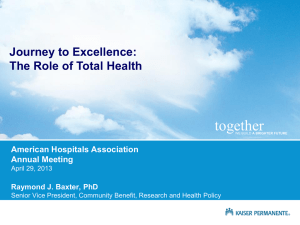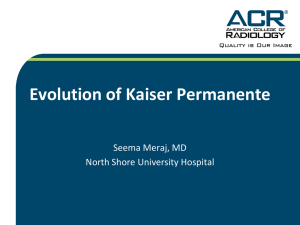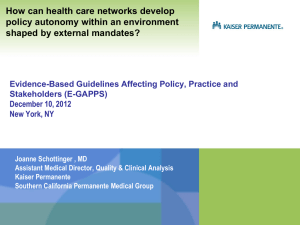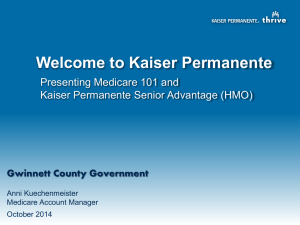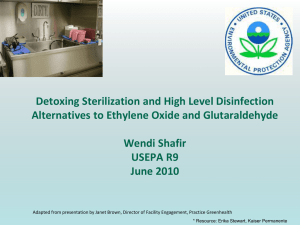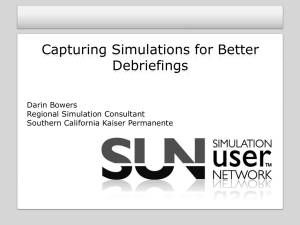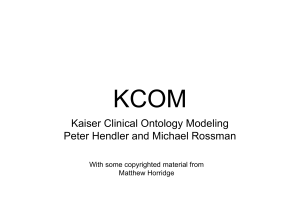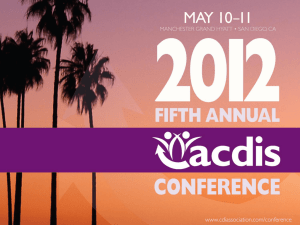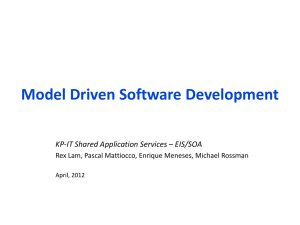Warning Signs
advertisement
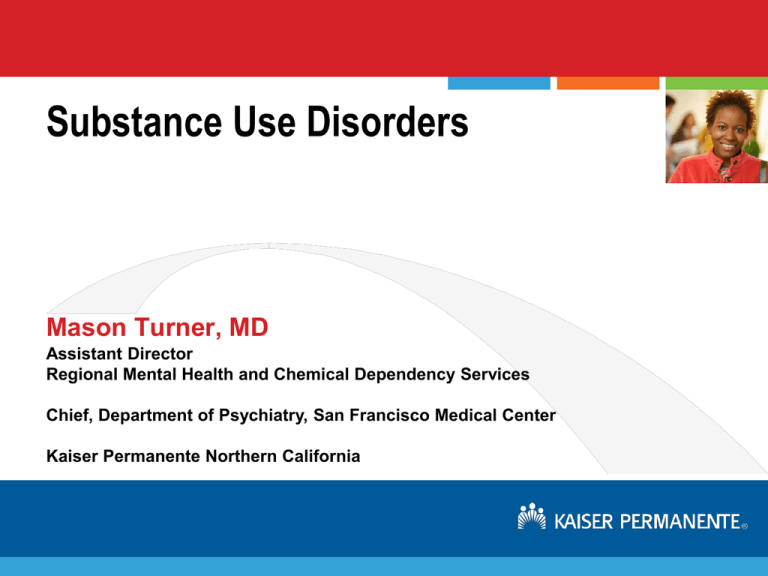
Substance Use Disorders Mason Turner, MD Assistant Director Regional Mental Health and Chemical Dependency Services Chief, Department of Psychiatry, San Francisco Medical Center Kaiser Permanente Northern California No Financial Disclosures 2 The Permanente Medical Group, Inc Alcohol and Drugs: Use or Abuse? Objectives Delineate the scope of the problem of drug and alcohol misuse Understand how personality type affects propensity to abuse substances Present the spectrum of problem substance use Describe ways of detecting problematic substance use in others Discuss what to do when you suspect a friend, family member, colleague or yourself, is misusing substances 3 The Permanente Medical Group, Inc “This is a disease that tells you that you don’t have it. It’s the only disease I know that argues with you and says, ‘Look, despite all the evidence, you don’t have a problem’” JD, age 64 from Coombs, R. Drug-Impaired Professionals. 1997. 4 The Permanente Medical Group, Inc “I didn’t think it could happen to me because I’m too smart and I have all this knowledge. I’m unique, a doctor, a cut or two above the average citizen. When I found out I was addicted, I was devastated. It sneaked up on me and had me by the throat before I even had an inkling.” MD, age 50 from Coombs, R. Drug-Impaired Professionals. 1997. 5 The Permanente Medical Group, Inc The Scope of the Problem 6 The Permanente Medical Group, Inc The Scope of the Problem: Alcohol 140 million individuals in the United States use alcohol each year. In 2009, the alcohol beverage sales economy topped almost $400 billion (includes liquor sales, wages, and other economic contributors). Direct sales of spirits account for $20 billion per year. Both grow by about 4% per year. (Distilled Spirits Council of the United States) Premium spirits are among the fastest growing segments of the alcohol beverage economy. Spending on alcohol actually goes up during times of economic distress. The “Liquor, Cigarette and Prostitute” hypothesis. 7 The Permanente Medical Group, Inc The Scope of the Problem: Alcohol Although estimates vary, about 10% of people who use alcohol will develop “problem” drinking at some point in their lives. While ethnic variation in ability to metabolize alcohol exists, rates of alcohol dependence do not vary by ethnicity. Men are over five times as likely as women to develop problematic drinking behaviors. 8 The Permanente Medical Group, Inc The Scope of the Problem: Alcohol Alcohol is a ubiquitous aspect of the social and occupational environment. Binge drinking is also problematic, with recent data demonstrating that almost 15% of individuals in the U.S. report having had 5+ drinks in one sitting in the last month. 9 The Permanente Medical Group, Inc The Scope of the Problem: Drugs Reliable statistics for drug use are not available; however, some studies demonstrate that as many as 30-40% of individuals in the U.S. have used an illicit substance at least once. Up to 80% of 12th graders in some studies report one time use, so this number is set to increase dramatically. Rates of abuse and dependence are high, ranging from 10-25% of all individuals who use, depending on the substance 10 The Permanente Medical Group, Inc The Scope of the Problem: Nicotine Nicotine remains a significant drug of abuse, with reports of as many as 60 million individuals in the U.S. who smoke regularly. Except among certain populations (mentally ill among them), rates of smoking are decreasing. Nicotine is thought to be nearly twice as addictive as heroin. Almost half of all individuals who ever try just one cigarette will become dependent on nicotine. 11 The Permanente Medical Group, Inc The Scope of the Problem: The Workplace Acute effects of alcohol and drug use include: Euphoria and feeling of invincibility Delayed reaction time Decreased memory function Diminishing social “filters” and poor interpersonal functioning (direct frontal lobe effect) Unreliability Activity in the areas of the brain that control reasoning and judgment is reduced. Rational thought is limited. 12 The Permanente Medical Group, Inc The Scope of the Problem: The Workplace Service professionals, such as attorneys and physicians, use and abuse substances and experience mental illness at greater rates than the general population. WHY??? 13 The Permanente Medical Group, Inc The Scope of the Problem: The Workplace Almost 20% of attorneys will develop a substance use disorder in their lifetimes, twice as high as the general population Approximately one-third of attorneys are dissatisfied with their career and would choose another profession if they could; Suicide is the third leading cause of death for attorneys after cancer and heart disease; Over half of lawyers experience stress at higher levels than the population Lauren Thibodeaux, personal communication 12/12/2011 14 The Permanente Medical Group, Inc The Scope of the Problem: The Workplace Financial pressure: Personal and institutional High expectations Competitive work environments Need for constant “performance” to clients, judges, other attorneys Long work hours All of which leads to…. 15 The Permanente Medical Group, Inc STRESS!!! 16 The Permanente Medical Group, Inc The Spectrum of Substance Use Diagnostic and functional terms exist across all substances, including nicotine and caffeine: – Use – Misuse – Abuse – Dependence 17 The Permanente Medical Group, Inc The Spectrum: Substance Use “Casual” or “Social” use Frequency not important Consequences do not occur May progress to abuse Can occur for alcohol as well as drugs Misuse involves using substances for inappropriate reasons (i.e., drinking to relieve tension). 18 The Permanente Medical Group, Inc The Spectrum: Substance Abuse As a direct result of substance use, one or more serious consequences occur: – Legal – Occupational/Educational – Social – Relational Substance use continues in spite of these consequences. 19 The Permanente Medical Group, Inc The Spectrum: Substance Abuse No signs of physical tolerance or withdrawal present Insight is usually impaired Frequently progresses to dependence Controlled use is possible, frequently outside of the context of a treatment program Difficult for clinicians to address 20 The Permanente Medical Group, Inc The Spectrum: Substance Dependence Features of abuse are present and are combined with the following: Uncontrolled use, in spite of frequent efforts to stop Physical tolerance or withdrawal are frequently, but not necessarily, present Use continues in spite of insight that substances are causing the problems. 21 The Permanente Medical Group, Inc The Spectrum: Substance Dependence Abstinence is widely recognized as the most appropriate goal, but is it? Most treatment programs target the dependent population, rather than substance abusing individuals. Harm reduction remains a viable treatment recommendation. All treatment options have proven efficacy 22 The Permanente Medical Group, Inc Warning Signs: Recognizing Problem Substance Use 23 The Permanente Medical Group, Inc Warning Signs: Safe Alcohol Use How much can one drink over his or her lifetime and have no greater chance of developing medical, psychological, or legal problems that are related to alcohol use than the baseline population who doesn’t drink? 24 The Permanente Medical Group, Inc Warning Signs: Safe Alcohol Use Safe Drinking Guidelines: Men 2 alcohol equivalents per day OR 4 alcohol equivalents, once per week, in one sitting Approximately 10-14 drinks per week 25 The Permanente Medical Group, Inc Warning Signs: Safe Alcohol Use Safe Drinking Guidelines: Women 1 alcohol equivalent per day OR 2 alcohol equivalents, once per week, in one sitting Approximately 7 drinks per week Women do not metabolize alcohol as efficiently as men, and cannot safely drink as much. 26 The Permanente Medical Group, Inc Warning Signs: Safe Alcohol Use Alcohol Equivalents 1.5 ounces of spirits (10 drinks per pint) 12 ounces of beer 6 ounces of wine (4-5 glasses per bottle) REMEMBER TO MEASURE!! 27 The Permanente Medical Group, Inc Warning Signs: Safe Drug Use Prescription drugs only (and only according to doctor’s orders) A great deal of controversy exists regarding “safe” use of illicit substances, but in reality, this probably can (and does) occur in limited situations 28 The Permanente Medical Group, Inc Warning Signs: Recognizing Problem Substance Use Spheres of Influence: Individual/Personal Family/Families of Choice Friends/Community Workplace/Professional These are guidelines only, and should be taken in the total context. Seek professional advice early and often! 29 The Permanente Medical Group, Inc Warning Signs: Individual/Personal Deteriorating personal hygiene and grooming Multiple physical complaints Frequent emergency room visits Frequent accidents and hospitalizations Personality and behavioral changes Inappropriate physical symptoms, such as tremors and / or sweating Emotional crises Irritable and short-tempered behavior 30 The Permanente Medical Group, Inc Warning Signs Family/Families of Choice Problem behavior is excused, rather than challenged and corrected Drinking activities are a priority Fights, arguments and violent outbursts are frequent. 31 The Permanente Medical Group, Inc Warning Signs Family/Families of Choice Fragmentation of family systems Abnormal, illegal, and antisocial actions, including child neglect and abuse Financial crises Sexual problems: Impotence and low libido Extramarital affairs Separation or divorce 32 The Permanente Medical Group, Inc Warning Signs: Friends/Community Personal isolation Embarrassing and inappropriate behavior Legal problems and criminal behavior Neglect of social commitments Unpredictable and erratic behavior, such as inappropriate spending 33 The Permanente Medical Group, Inc Warning Signs: Workplace/Professional Work Environment and Comportment Excessive work habits (i.e., a Type A Workaholic), a frequent cause of problem substance use Disorganized schedule Prolonged lunch breaks Decreased workload and tolerance Frequent office absences, including frequent use of sick leave , i.e., “Monday morning flu” Frequent tardiness to client appointments and staff meetings 34 The Permanente Medical Group, Inc Warning Signs: Workplace/Professional Interpersonal Interactions Unreasonable expectations of others Unpredictable, changing or inappropriate behavior. Inaccessibility to clients and staff Frequent complaints by clients and staff regarding behavior or work performance Heavy drinking and intoxication at staff functions 35 The Permanente Medical Group, Inc Warning Signs: Workplace/Professional Other Professional Warning Signs Frequent job changes or relocation Unusual medical history Vague letters of reference Frequent lying Misrepresentation of qualifications to clients or staff Increasing or excessive malpractice incidence or disciplinary actions 36 The Permanente Medical Group, Inc Help Is Available! 37 The Permanente Medical Group, Inc Responding to a Problem Developmental Perspectives: Stages of Change Pre-contemplative Contemplative Preparation Action Recovery 38 The Permanente Medical Group, Inc Responding to a Problem Recognition of your Role Spouse/Partner Friend Colleague Supervisor/Manager Patient 39 The Permanente Medical Group, Inc Responding to a Problem: General Express concern and empathy Use concrete observations “I feel” is better than “You make me feel.” Confrontation is rarely useful, but occasionally necessary For substance abuse, insight-oriented discussions are important 40 The Permanente Medical Group, Inc Responding to a Problem: Spouse/Partner Avoid enabling behavior and co-dependency. A pound of prevention is worth an ounce of cure. Know your limits and address issues before you reach them. Al-Anon and CODA are important acronyms. Protect your family and yourself above all 41 The Permanente Medical Group, Inc Responding to a Problem: Friend Use honest and open communication Enlist support from spouses and partners, i.e., interventions Discuss personal experiences with addiction if relevant 42 The Permanente Medical Group, Inc Responding to a Problem: Colleague To the extent possible, respond as a friend and not a colleague, using personal, not professional, influence Performance issues should be directed to the individual’s supervisor or manager, and not to that person directly (with some caveats) Respond only with factual information or concerns. Avoid gossip 43 The Permanente Medical Group, Inc Responding to a Problem: Supervisor/Manager Use concrete, specific performance issues to guide discussions. Limit identification of specific employees who have expressed concerns, if applicable Utilize the Employee Assistance Program 44 The Permanente Medical Group, Inc Responding to a Problem: Supervisor/Manager Resist overextension of your role. Details of medical treatment are not appropriate for discussion. Create an action plan for performance improvement and hold the individual to it. Utilize human resources and legal resources for consultation and for legal protection/information. 45 The Permanente Medical Group, Inc Responding to a Problem: Patient Don’t be afraid! Help is available! Listen to those who express their concerns (professional treatment groups are a must). Seek professional advice and consultation ASAP. Realize that alcohol and drug use can progress. Today’s use is tomorrow’s dependence Respond to the concerns of others, while realizing that your health and well being is your responsibility and your primary goal. 46 The Permanente Medical Group, Inc Responding to a Problem: Resources Self assessment tests Alcoholics Anonymous www.aa.org Life Ring www.lifering.com Al-Anon www.alanon.alateen.org Substance Abuse and Mental Health Services Administration www.samhsa.gov Your personal care providers 47 The Permanente Medical Group, Inc 48 The Permanente Medical Group, Inc
